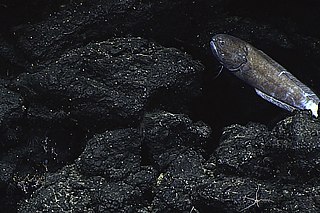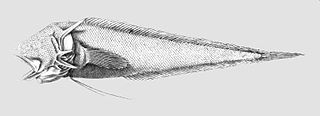
Rendahl's messmate is a pearlfish of the family Carapidae, found in the southwest Pacific Ocean around Australia and New Zealand at depths to 60 metres (200 ft). Its length is between 10 and 12 centimetres .The larvae has a long filament on its head which bears some resemblance to a siphonophore. These fish live within sponges. The specific name honours the Swedish naturalist and artist Hialmar Rendahl who collected the specimens in the Tasman Sea which were used by Gilbert Percy Whitley to describe this species.

The longnose catshark is a catshark of the family Scyliorhinidae found in the eastern central Pacific from central and southern California and the Gulf of California, between latitudes 38° N and 23° N, at depths down to 1,890. Its length is up to 58 cm.
Haplochromis worthingtoni is a species of cichlid endemic to Lake Kyoga in Uganda. This species reaches a length of 14.1 centimetres (5.6 in) SL. The specific name honours the explorer E. Barton Worthington (1905–2001) who collected the type of this species with type with Michael Graham.

The pindani is a species of cichlid endemic to Lake Malawi preferring areas with sandy substrates and nearby rocks where the males establish their territories. This species can reach a length of 6.7 centimetres (2.6 in) SL. It can also be found in the aquarium trade. The specific name of this fish honours the aquarium fish trader Ross Socolof (1925-2009).
The whitelined toadfish is a species of fish in the family Batrachoididae. It is endemic to Belize. The specific name honours David W. Greenfield and Teresa Arambula Greenfield, who when they collected type specimen thought that it might belong to an undescribed species and so sent it to Bruce Baden Collette to be described.
Antennablennius simonyi, Simony's blenny, is a species of combtooth blenny found in the western Indian Ocean, from the Gulf of Aden to the Persian Gulf.
Onuxodon is an Indo-Pacific genus of pearlfishes from the family Carapidae. The generic name is derived from the Greek onyx meaning "claw" and odon meaning "tooth", referring to the sharp fang like teeth of Onuxodon parvibrachium. Species in this genus are distributed from South Africa to Hawaii. They live commensally with molluscs. The three currently recognized species are:

Snyderidia canina is a species of pearlfish found in all tropical waters but those of the eastern Pacific Ocean, depths from 110 to 1,762 m. This species grows to a length of 26.8 cm (10.6 in). This fish is the only known species in its genus which was named in honour of the ichthyologist John Otterbein Snyder (1867-1943) for the assistance he lent to Charles Henry Gilbert on the cruise to Hawaii on which the type specimen was collected.
Alcockia is a genus in the cusk-eel family. It contains only the single species Alcockia rostrata, which is found in the Indian and western Pacific Oceans, at depths of from 2,761 to 4,040 metres. This species grows to a length of 35 centimetres (14 in) SL. The generic name Alcockia honours Alfred William Alcock (1859-1933) who was the surgeon-naturalist aboard the R.I.M.S. Investigator.
Bassogigas is a genus of cusk eel from the subfamily Neobythitinae, part of the family Ophidiidae. The generic name "Bassogigas" comes from a combination of two Latin words: bassus, which means "deep" and gigas which means "giant". The species are found in the Indo-Pacific and western Atlantic Ocean.
The Australian tusk, Dannevigia tusca, is a species of cusk-eel found in the waters off of the Great Australian Bight occasionally to Bass Strait at depths from 115 to 400 m. This species grows to 56 cm (22 in) in total length. It is the only known member of its genus and the generic name honours Harold Christian Dannevig (1860-1914) who was the Director of Fisheries for the Australian government, who collected type specimen and who was later lost at sea when the fisheries research vessel he was working on vanished without a trace.

The needletooth cusk is a species of cusk-eel found in the Indian and the western Pacific Ocean where it occurs at depths of 1,000 to 1,750 metres. This species grows to a length of 21.5 centimetres (8.5 in) SL. It is the only known species of its genus The generic name is a compound of the Greek epetrion meaning "needle" and odous meaning "tooth", while the specific name honours the English ichthyologist Norman Bertram “Freddy” Marshall (1915-1996) who worked on deep sea fishes as the British Museum.
The banded cusk-eel is a species of cusk-eel found along the southeast coast of South America from southern Brazil to northern Argentina. It occurs at depths of from 40 to 150 metres and is of minor importance in commercial fisheries. This species grows to a length of 31 centimetres (12 in) TL. It is the only known member of its genus. The generic name honours the American ichthyologist Edward C. Raney (1909–1984) of Cornell University who introduced the describer Charles R. Robins to ichthyology.

Sirembo is a genus of cusk-eels of the subfamily Neobythitinae, family Ophidiidae, which are found in the Indian and Pacific Oceans. The species in this genus have a rather robust body with the dorsal fin originating over vertebrae 1–5. The head and bod are completely covered in scales, they have large eyes which are almost equal in diameter to the length of snout, the pelvic fins have two rays which are joined together within an area of tough skin, They have a short spine on the operculum which does not extend to the posterior edge of the head. Their coloration is variable but almost all species have black spots or eyespots on the dorsal fin, sometimes both, while the middle part of the anal fin frequently has a black band. The body and/or head are marked with diagonal or horizontal dark stripes or horizontal rows of quite large dusky spots.

Tauredophidium hextii is a species of cusk-eel found in the Indian and western Pacific Oceans. It occurs at depths of from 1,500 to 2,660 metres. This species grows to a length of 10.5 centimetres (4.1 in) SL. It is the only known member of its genus. The specific name honours Rear-Admiral John Hext (1842-1924) who was commander of the Royal Indian Marine who supported the expedition in board the R.I.M.S. Investigator in the Arabian Sea which collected the type specimen.
The East Pacific ventbrotula is a species of cusk-eel found around thermal vents on the southern East Pacific Rise at depths of about 2,586 metres (8,484 ft). This species grows to a length of 28.2 centimetres (11.1 in) SL. It is the only known member of its genus. The generic name is a compound of vent, for the Oasis hydrothermal vent on the south East Pacific Rise and the Greek ichthys meaning "fish", while the specific name refers to the French BIOSPEEDO expedition to the south East Pacific Rise which collected the type specimen in 2004.

Roche's snake blenny is a fish species in the genus Ophidion and the family Ophidiidae. Widespread in the Mediterranean Sea in western and northern regions, also in the Black Sea, Sea of Marmara and it has been recorded in the Atlantic. Marine subtropical demersal fish, up to 29.3 centimetres (11.5 in) long. This fish species has distinctive sonic capabilities, produced by the dorsal, intermediate, and ventral sonic muscles. Additionally, females tend to produce sounds having short duration and pulsation, while male sounds are longer and show a unique pattern of pulsation, resulting in characteristic distinctions between the Ophidion rochei and the Ophidion barbatum, its twin species. The specific name honors the Swiss physician and naturalist François-Etienne Delaroche (1780-1813), who wrote about the distinctive swim-bladder anatomy of Ophidion barbatum in 1809.
The basketweave cusk-eel is a fish species in the family Ophidiidae. It is widespread in the eastern Pacific Ocean from Point Arguello in California, United States, to Baja California. The basketweave cusk-eel is a marine subtropical demersal fish that can be up to 28 centimetres (11 in) long. The specific name honors the journalist and philanthropist Ellen Browning Scripps (1836-1932) one of the founders of the Scripps Research Institute.
The silver pearlfish, Encheliophis homei, is a species of eel-like fish in the family Carapidae. This pearlfish lives inside the coelom of sea cucumbers such as Bohadschia argus, Thelenota ananas , and Stichopus chloronotus. It is native to tropical and subtropical parts of the Indo-Pacific Ocean.

Lamprogrammus shcherbachevi, the scaleline cusk, is a species of marine ray-finned fish in the family Ophidiidae.











